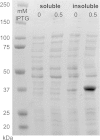Regulation of the expression level of transcription factor XylS reveals new functional insight into its induction mechanism at the Pm promoter
- PMID: 24252441
- PMCID: PMC4225500
- DOI: 10.1186/1471-2180-13-262
Regulation of the expression level of transcription factor XylS reveals new functional insight into its induction mechanism at the Pm promoter
Abstract
Background: XylS is the positive regulator of the inducible Pm promoter, originating from Pseudomonas putida, where the system controls a biochemical pathway involved in degradation of aromatic hydrocarbons, which also act as inducers. The XylS/Pm positive regulator/promoter system is used for recombinant gene expression and the output from Pm is known to be sensitive to the intracellular XylS concentration.
Results: By constructing a synthetic operon consisting of xylS and luc, the gene encoding luciferase, relative XylS expression levels could be monitored indirectly at physiological concentrations. Expression of XylS from inducible promoters allowed control over a more than 800-fold range, however, the corresponding output from Pm covered only an about five-fold range. The maximum output from Pm could not be increased by introducing more copies of the promoter in the cells. Interestingly, a previously reported XylS variant (StEP-13), known to strongly stimulate expression from Pm, caused the same maximum activity from Pm as wild-type XylS at high XylS expression levels. Under uninduced conditions expression from Pm also increased as a function of XylS expression levels, and at very high concentrations the maximum activity from Pm was the same as in the presence of inducer.
Conclusion: According to our proposed model, which is in agreement with current knowledge, the regulator, XylS, can exist in three states: monomers, dimers, and aggregates. Only the dimers are active and able to induce expression from Pm. Their maximum intracellular concentration and the corresponding output from Pm are limited by the concentration-dependent conversion into inactive aggregates. Maximization of the induction ratio at Pm can be obtained by expression of XylS at the level where aggregation occurs, which might be exploited for recombinant gene expression. The results described here also indicate that there might exist variants of XylS which can exist at higher active dimer concentrations and thus lead to increased expression levels from Pm.
Figures






Similar articles
-
The XylS/Pm regulator/promoter system and its use in fundamental studies of bacterial gene expression, recombinant protein production and metabolic engineering.Microb Biotechnol. 2017 Jul;10(4):702-718. doi: 10.1111/1751-7915.12701. Epub 2017 Mar 9. Microb Biotechnol. 2017. PMID: 28276630 Free PMC article. Review.
-
Expression of the TOL plasmid xylS gene in Pseudomonas putida occurs from a alpha 70-dependent promoter or from alpha 70- and alpha 54-dependent tandem promoters according to the compound used for growth.J Bacteriol. 1996 Apr;178(8):2356-61. doi: 10.1128/jb.178.8.2356-2361.1996. J Bacteriol. 1996. PMID: 8636038 Free PMC article.
-
Genetic evidence that the XylS regulator of the Pseudomonas TOL meta operon controls the Pm promoter through weak DNA-protein interactions.J Bacteriol. 1994 Jun;176(11):3171-6. doi: 10.1128/jb.176.11.3171-3176.1994. J Bacteriol. 1994. PMID: 8195070 Free PMC article.
-
Cross talk between catabolic pathways in Pseudomonas putida: XylS-dependent and -independent activation of the TOL meta operon requires the same cis-acting sequences within the Pm promoter.J Bacteriol. 1994 Sep;176(17):5578-82. doi: 10.1128/jb.176.17.5578-5582.1994. J Bacteriol. 1994. PMID: 8071244 Free PMC article.
-
Transcriptional control of the Pseudomonas TOL plasmid catabolic operons is achieved through an interplay of host factors and plasmid-encoded regulators.Annu Rev Microbiol. 1997;51:341-73. doi: 10.1146/annurev.micro.51.1.341. Annu Rev Microbiol. 1997. PMID: 9343354 Review.
Cited by
-
Standardization of regulatory nodes for engineering heterologous gene expression: a feasibility study.Microb Biotechnol. 2022 Aug;15(8):2250-2265. doi: 10.1111/1751-7915.14063. Epub 2022 Apr 27. Microb Biotechnol. 2022. PMID: 35478326 Free PMC article.
-
The XylS/Pm regulator/promoter system and its use in fundamental studies of bacterial gene expression, recombinant protein production and metabolic engineering.Microb Biotechnol. 2017 Jul;10(4):702-718. doi: 10.1111/1751-7915.12701. Epub 2017 Mar 9. Microb Biotechnol. 2017. PMID: 28276630 Free PMC article. Review.
-
MsmR1, a global transcription factor, regulates polymyxin synthesis and carbohydrate metabolism in Paenibacillus polymyxa SC2.Front Microbiol. 2022 Nov 22;13:1039806. doi: 10.3389/fmicb.2022.1039806. eCollection 2022. Front Microbiol. 2022. PMID: 36483206 Free PMC article.
-
Physical decoupling of XylS/Pm regulatory elements and conditional proteolysis enable precise control of gene expression in Pseudomonas putida.Microb Biotechnol. 2020 Jan;13(1):222-232. doi: 10.1111/1751-7915.13383. Epub 2019 Mar 12. Microb Biotechnol. 2020. PMID: 30864281 Free PMC article.
-
Benzoic Acid-Inducible Gene Expression in Mycobacteria.PLoS One. 2015 Sep 8;10(9):e0134544. doi: 10.1371/journal.pone.0134544. eCollection 2015. PLoS One. 2015. PMID: 26348349 Free PMC article.
References
-
- Mergulhão FJM, Monteiro GA, Cabral JMS, Taipa MA. Design of bacterial vector systems for the production of recombinant proteins in Escherichia coli. Microbiol Biotechnol. 2004;14:1–14.
MeSH terms
Substances
LinkOut - more resources
Full Text Sources
Other Literature Sources

